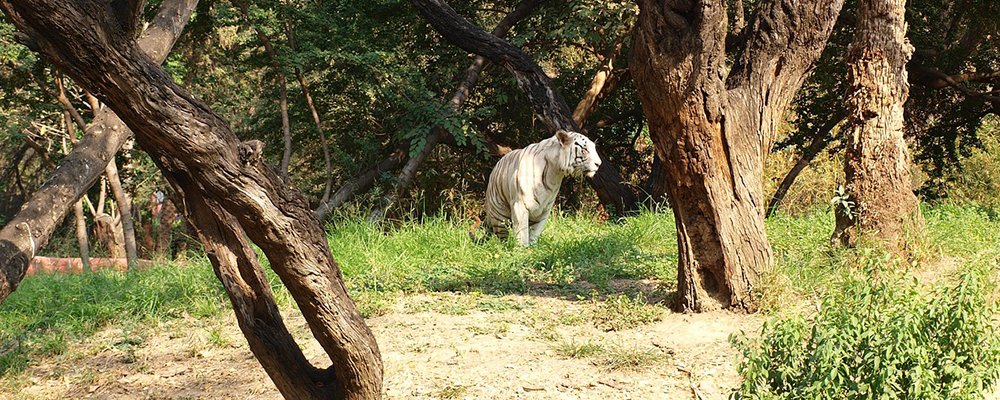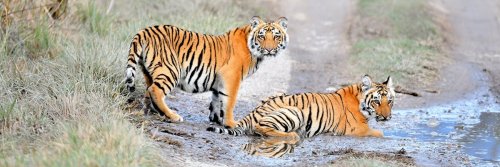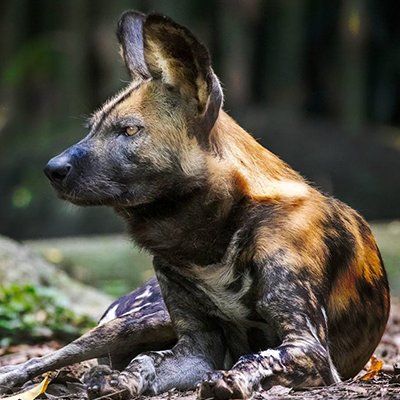The elusive tiger, a big and not-so-cuddly cat, is believed to have been in India for the last 12,000 to 16,500 years. These large, beautiful animals are also known as the Bengal tiger. Wearing a cloak of varying hues of reddish-orange with individual markings of dark black or brown stripes, they have long been a symbol of strength, power, grace, and cunning. A male tiger can grow up to ten feet long and weigh over 500 pounds, making it the world's second-largest cat (the largest is the Siberian tiger).
An apex predator, their size gives them a majestic presence that is wrapped up in myths and legends and plays a part in India's history from when kings and nobles riding elephants indulged their passion for tiger hunting. The Goddess Durga, the guardian of good against evil in Hindu Mythology, is depicted on top of a tiger, and the 'lady of the forest'—Bonbibi or Bandevi—is a guardian spirit in both Muslim and Hindu stories who keeps people safe from man-eating tigers when hunting or gathering wood in the forest. The Baiga tribe, who live in various tiger reserves in central India, believe they are descendants of the tiger. The word 'tiger' stems from the Persian or Iranian language, meaning 'arrow,' and in India, 'arrow' is the Urdu word for 'Teer.'
India is home to the largest number of tigers in the world, more than 3,600, representing 75% of the globe's population. They roam India's landscape, from grasslands and mangroves to forests in central India's famous reserves, the remote northeast, the jungles in the south, and the dusty region of Gujarat. India is proactive in tiger conservation via various protocols such as reducing human-wildlife conflict and habitat loss, enforcing strict anti-poaching laws, and creating protected tiger reserves and national parks.
Below are some of the protected areas known for their high tiger populations, which give tourists every opportunity to gawk in awe at one of nature's most formidable animals and hear their powerful roar.
Ranthambore National Park, Rajasthan
Open from November to April annually, Ranthambore National Park sits about 130km from Jaipur near the town of Sawai Madhopur. It's known for its rich history as the hunting grounds of the Maharajas of Jaipur. One of the biggest parks in India, Ranthambore blankets 400 sq mts and has relics of buildings from bygone eras littering the jungle, a massive fort that dominates a hill in the park, and numerous bodies of water providing thirsty creatures relief from the scorching heat. Initially named the Sawai Madhopur Game Sanctuary in 1955, it was in 1973 declared a Project Tiger Reserve, and later in 1980 declared a national park. Adjacent to Ranthambore National Park, the dense forests of Keladevi Sanctuary and Sawai Man Singh Sanctuary are both wildlife habitats. Ranthambore is where history and wildlife viewing morph into one exceptional experience. Apart from tigers, the wildlife list includes leopards, sloth bears, sambar, langur, macaque monkeys, wild boars, cobras, and crocodiles.

Pench National Park, Madhya Pradesh
Open from October to June, with the best months from March to May, the stunning Pench National Park puts on an unbelievable show of wildlife in its teak forests and panoramic grasslands. It's located 92km from the major city of Nagpur, Maharashtra. One of three famous parks in India for wildlife viewing and bird watching, Pench National Park is India's first (Asia's fifth) 'Dark Sky Park'—preserving natural darkness for conservation—combatting light pollution. Only the stars will twinkle in the heavens across this park, allowing the black night skies to be a powerhouse of stars.
Pench National Park is known for its entanglement with Rudyard Kipling's 'The Jungle Book' as this story fantasizes the valid account of a child who supposedly grew up with wolves in the area in 1831, based on a pamphlet 'An Account of Wolves Nurturing Children in their Dens' by Sir William Henry Sliman. Meandering this park of river streams, old villages, and forests are numerous species apart from Bengal tigers that include leopards, wild dogs, jackals, wolves, wild cats, wild pigs, and many more, with a plethora of birdlife, both resident and migratory—vultures, kingfisher, and junglefowl to name a few of the 250 different species.
Other parks where tigers stalk their prey and talk to each other with their tails—a relaxed tiger will have his tail loosely hanging, while when being aggressive, its tail will hang low and twitch—include the Bandhavgarh National Park, where you may be lucky to see the ghostly sight of a white tiger with stunning blue eyes, the Corbett National Park which is the oldest park in India established in 1935, and the Tadoba-Andhari Tiger Reserve famous for its thriving tiger population.
Gail Palethorpe, a self proclaimed Australian gypsy, is a freelance writer, photographer and eternal traveller. Check out her website Gail Palethorpe Photography and her Shutterstock profile.















